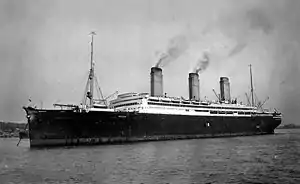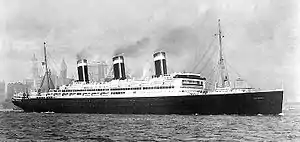Imperator-class ocean liner
The Imperator class ocean liners were a series of three ocean liners designed for the Hamburg America Line, commonly known as HAPAG. These three ships were commissioned by the chairman of HAPAG Albert Ballin. Namely the Imperator (1912), the Vaterland (1913) and the largest, the Bismarck (1914). These liners were over 50,000 tons, sported three funnels and had a length ranging from 906 ft (276 m) to 956 ft (291 m). To this day, the Vaterland is the largest passenger ship operated by a German shipping company.
 The first Imperator class liner, the Imperator | |
| Class overview | |
|---|---|
| Builders: | AG Vulcan Stettin, Germany |
| Built: | 1912–1914 |
| In service: | 1913–1946 |
| Planned: | 3 |
| Completed: | 3 |
| Retired: | 3 |
| General characteristics | |
| Type: | Ocean liner |
| Tonnage: | 52,117 - 56,551 GT |
| Length: | 906 ft (276 m) - 956 ft (291 m) |
| Beam: | 98 ft 3 in (29.95 m) - 100.1 ft (30.5 m) |
| Draught: | 35 ft 2 in (10.72 m) - 37 ft 9 in (11.5 m) |
Background
The Hamburg America Line was one of two German shipping companies which operated transatlantic crossings, the other being North German Lloyd. The latter had had much success with the advent of their so-called Kaiser-class ocean liners, the first of which was the Kaiser Wilhelm der Grosse. Lloyd soon had a fleet of four liners with weekly transatlantic crossings on offer. By the turn of the century, HAPAG had only one flagship the Deutschland. Though successful, the Deutschland could not rival the "Four Flyers" owned by Lloyd. HAPAG soon added the Kaiserin Auguste Viktoria to their fleet which was the largest ship in the world at its launch in August 1906. British competition was also fierce, Cunard's Lusitania launched in 1906 followed by her sister Mauretania were an instant success and by 1910, the new Olympic-class ocean liners of White Star were nearing completion.


External links
 Media related to Imperator class ocean liners at Wikimedia Commons
Media related to Imperator class ocean liners at Wikimedia Commons- Imperator Class Liners-Germany's Big Three on YouTube